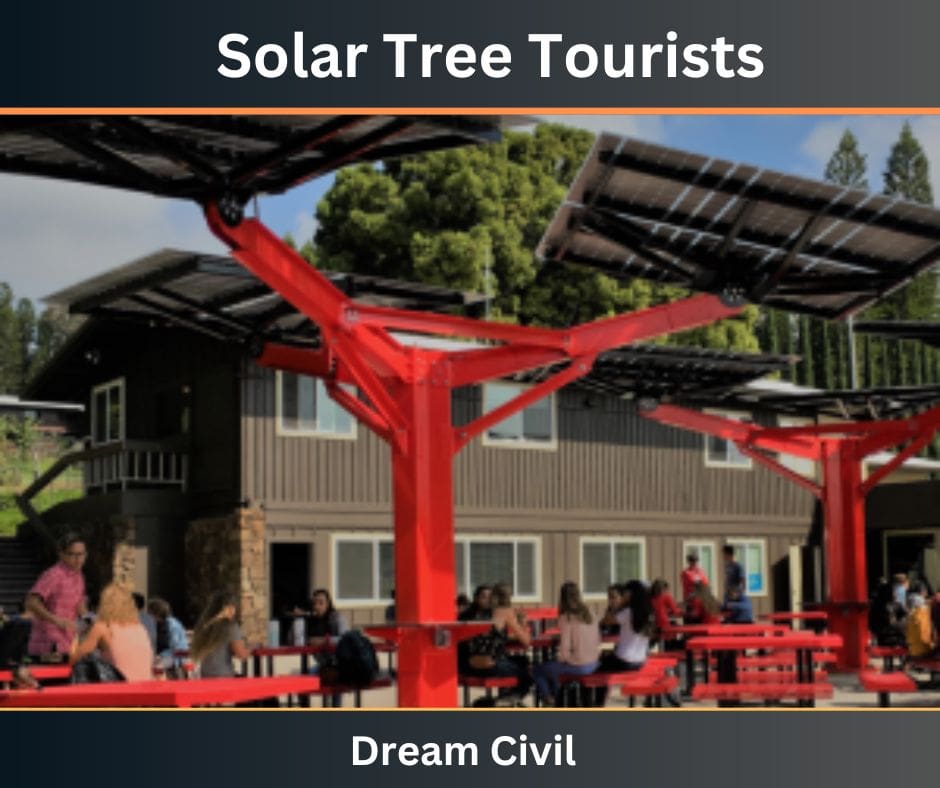Table of Contents
The solar tree can be defined as the spiral phyllotaxy structure of solar panels within a single pillar.
Energy from the sun called solar energy is the most abundant freely available energy on the earth.
In the last two decades, solar energy has contributed a lot as alternative renewable energy to the world significantly.
This solar energy has been utilized by a device called a solar panel. The solar panel contains different solar cells.
Solar cells are made up of semiconductor materials like silicon, gallium, arsenide, and cadmium Telluride.
But mostly with polycrystalline/monocrystalline pure silicon extracted from the second most abundant element ‘sand’ undergoing various processes.
A solar cell is a device that directly converts light energy (photons) into electrical energy (DC) based on the photovoltaic effect principle.
Installation of solar panels can take up a large part of the land which is unusual. Thus, to solve such a problem, the solar tree has been introduced so far.
This is the best kind of technology for energy generation and utilization of solar power.

1. Why it is called a Solar Tree?
It is because multiple solar panels are attached to a single pillar forming a tree-like structure.
(Like trees produce oxygen by photosynthesis using sunlight; they also use sunlight to produce direct current from solar power.)
2. Objectives of Solar Tree
a. To promote public awareness, technology, utilization, and adoption of an alternative renewable source of energy.
b. To enhance the present land urbanization issues and architectural aesthetics appearance.
c. To encourage humans in the utilization of available solar energy.
d. To make electricity accessible even in underdeveloped areas.
3. Origin and Development of Solar Tree
To utilize land, support urban infrastructure, and attract people towards solar energy; many designers, solar & environment artists, and manufacturers have launched these tree installations in many places like commercial buildings, schools, offices, public areas, roadways, street lights, and so on.
In 2012, Ross Lovegrove, a Welsh Industrial Designer known for his organic-inspired designs introduced the seating, lighting, and circular groupings of photovoltaic cells ( i.e. solar panels are arranged in a spiral phyllotaxy structure called solar tree) for the first time.
At present, there are several solar trees in the world like Lovegrove Solar Tree, Spotlight Solar Structure, CSIR-CMERI Solar Tree, and so on.
Among them, the CSIR-CMERI Solar Tree in Durgapur, West Bengal of India is the world’s largest solar tree.
The CSIR and CMERI have installed the solar tree in collaboration in a bid to promote renewable energy to expand the use of solar energy.
This tree has 35 solar photovoltaic (PV) modules with 330WP (watt-peak) capacity on each that costs nearly $9,595. It also has capabilities to adapt a bevy of IOT (Internet Of Things) based features.

4. Working Mechanism of Solar Tree
a. When sunlight (photons) strikes the solar cells (PV cells); solar energy is converted into electrical energy (DC) in the PV leaf and thus produced direct current is used to charge the battery.
b. It is also provided with an inverter that converts stored DC into suitable AC.
c. The solar tree is programmed such that it automatically rotates to face the sun to maximize production.
d. The base of the solar tree is made up of wood to eliminate current flow to the ground. The solar tree can be of different shapes like flat panels and Fibonacci solar trees.
5. Components of Solar Tree
It has a lifetime of 25 years based on various circumstances and the quality of its components.
Solar tree consists of many components. Some important components are:
1. Crystalline Solar PV modules
PV system consists of 6 individual components; a solar PV array, a charge controller, a battery bank, an inverter, a utility meter, and an electric grid.
The solar PV modules are attached to the structure as leaves. They should be handled carefully during the transportation and installation process to prevent mechanical damage.
2. Trunk structure
A trunk is a metallic structure to hold the solar panels attached to it at a certain angle of inclination as arms.
3. Electric wires or cables
Electric cables made up of copper material are utilized.
4. Wooden base
The base of the solar tree is made up of wood for electric insulation and support. Wood material may deform to a certain limit within its lifetime.

6. Applications of Solar Tree
Some of the application fields of the solar tree are:
1. Agricultural field
The CSIR-CMERI has provided the facility of IOT-based features in solar trees for provisions like to use of e-tractors, rainfall prediction, soil analytics, round-the-clock CCTV surveillance, real-time humidity measuring, etc using electrical energy generated by itself. They are also used to power tillers, pumps, etc.
2. Commercial Buildings
In various companies, factories, offices, schools, etc. They can be installed with proper land management.
3. Residential Sites
Residential areas like colonies can be benefitted from solar trees.
They are also used in green or net-zero energy buildings.
They can also be easily installed/placed on balconies, verandahs, private gardens, etc.
4. Highways
They can be installed across highways to power lighting systems and surveillance cameras.

5. Coastlines
They can be used on coastlines as on highways.
6. Public Places
They can be installed at public places like parks, gardens, tourist spots, etc to power lighting as well as to increase aesthetic appearance.

7. Advantages
a. It is eco-friendly.
b. Its Installation can enhance land utilization ( i.e. maximum power can be generated from a small area).
c. It can promote awareness, understanding, and adoption acknowledging renewable energy.
d. It is flexible to rotate and easy to handle.
e. They also give shadows beneath them.
f. It improves aesthetics.
8. Disadvantages
a. It is expensive to install.
b. It can cause difficulties in eyesight due to solar reflections.
9. References1. Content Filter & Authenticity Checking Team, Dream Civil International (Our team checks every content & detail to maintain quality.) |
Read Also: Bamboo as a construction material

